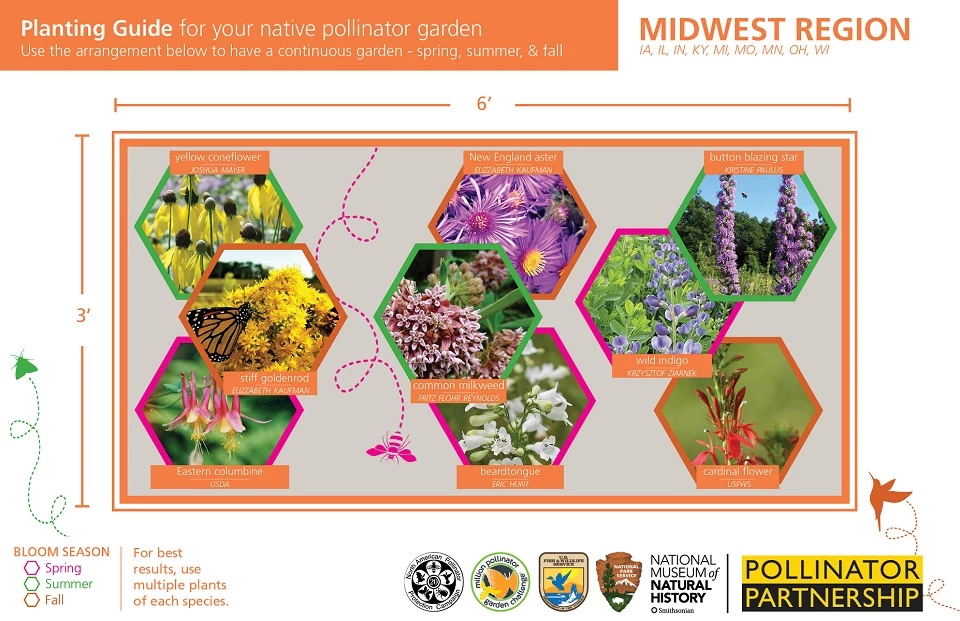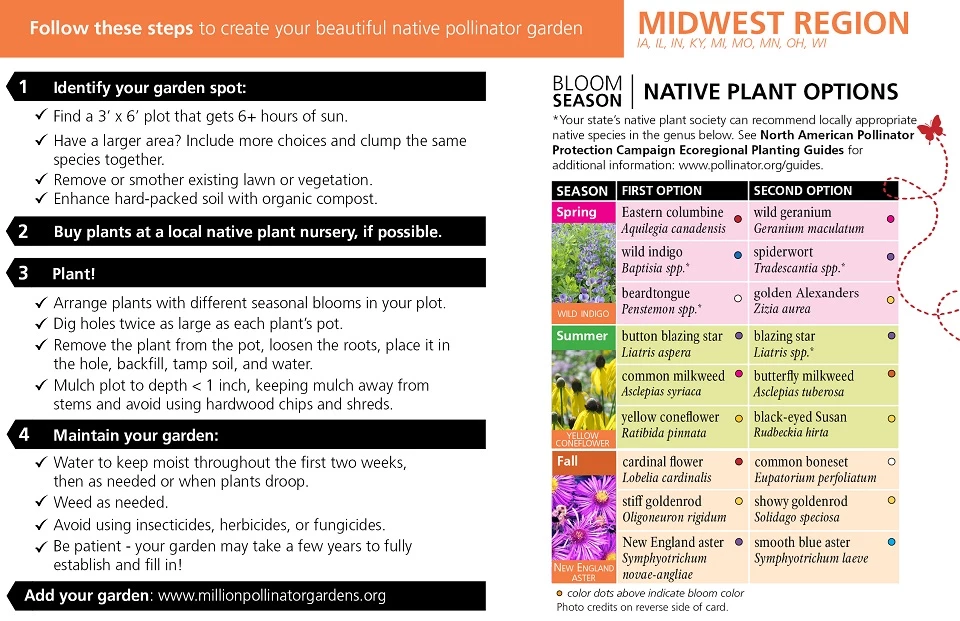Pollinator Planting Guide Cards - by EcoregionDownload and print a copy of the card appropriate for your region Midwest Region Pollinator Planting Card (2-sided) 

Left image
Right image
Side 1:
Planting Guide for your native pollinator garden Use the arrangement below to have a continous garden - spring, summer, fall Midwest Region States that this card applies to: IA, IL, IN, KY, MI, MO, MN, OH, WI This card includes an illustration of a 3'x6' garden bed with a mixture of nine pollinator-friendly plants. The flower bed is set up with flowers for spring, summer, and fall. Arrange plants shorter on outside of plot. Flowers include: yellow coneflower (summer), stiff goldenrod (fall), eastern columbine (spring), New England aster (fall), common milkweed (summer), beardtongue (spring), button blazing star (summer), wild indigo (spring), cardinal flower (fall) This card was produced by the following partners: North American Pollinator Protection Campaign, Million Pollinator Garden Challenge, U.S. Fish and Wildlife Service, National Park Service, National Museum of Natural History Smithsonian Institute, and Pollinator Partnership. Side 2: Follow these steps to create your beautiful native pollinator garden 1. Identify your garden spot: - Find a 3'x6' plot that gets 6+ hours of sun. - Have a larger area? Include more choices and clump the same species together. - Remove or smother existing lawn or vegetation. 2. Buy plants at a local native plant nursery, if possible. 3. Plant! - Arrange plants with different seasonal blooms in your plot. - Dig holes twice as large as each plant's pot. - Remove the plant from the pot, loosen the roots, place it in the hole, backfill, tamp soil, and water. - Mulch plot to depth <1 inch="" /> 4. Maintain your garden: - Water to keep moist throughout the first two weeks, then as needed or when plants droop. - Weed as needed. - Avoid using insecticides, herbicides, or fungicides. - Be patient - your garden may take a few years to fully establish and fill in! Add your garden: www.millionpollinatorgardens.org Native Plant Options: *Your state’s native plant society can recommend additional locally appropriate native species. See North American Pollinator Protection Campaign Ecoregional Planting Guides for additional information: www.pollinator.org/guides Season - Spring First options: Eastern columbine [red bloom] (Aquilegia canadensis), wild indigo [blue bloom] (Baptisia spp.*), beardtongue [white bloom] (Penstemon spp. *) Second options: wild geranium [pink bloom] (Geranium maculatum), spiderwort [purple bloom] (Tradescantia spp.*), golden Alexanders [yellow bloom] (Zizia aurea) Season - Summer First options: button blazing star [purple bloom] (Liatris aspera), common milkweed [pink bloom] (Asclepia syriaca), yellow coneflower [yellow bloom] (Ratibida pinnata) Second options: blazing star [purple bloom] (Liatris spp.*), butterfly milkweed [orange bloom] (Asclepias tuberosa), black-eyed Susan [yellow bloom] (Rudbeckia hirta) Season - Fall First options: cardinal flower [red bloom] (Lobelia cardinalis), stiff goldenrod [yellow bloom] (Oligoneuron rigidum), New England aster [purple bloom] (Symphyotrichum novae-angliae) Second options: common boneset [white bloom] (Eupatorium perfoliatum), showy goldenrod [yellow bloom] (Solidago speciosa), smooth blue aster [blue bloom] (Symphyotrichum laeve) |
Last updated: April 15, 2022
